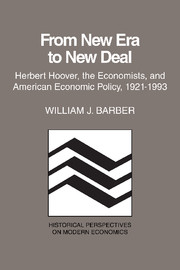Book contents
- Frontmatter
- Contents
- Preface
- Prologue: The vision of a new era in the 1920s
- 1 The ingredients of a model of a new economics
- 2 Challenges to the new economics of the 1920s
- 3 The new economics at center stage in 1929
- 4 Activating the stabilization model in late 1929 and 1930
- 5 Preliminary readings of the results of the stabilization strategy
- 6 The unraveling of the first official model in 1931
- 7 Shifting course in late 1931 and early 1932
- 8 Renewing the offensive in February and March 1932
- 9 The economists and their views on policy for 1932
- 10 Official model II as shaped in May 1932 and the aftermath
- Epilogue: Transition to the New Deal – continuities and discontinuities
- Notes
- Selected bibliography
- Index
Prologue: The vision of a new era in the 1920s
Published online by Cambridge University Press: 19 October 2009
- Frontmatter
- Contents
- Preface
- Prologue: The vision of a new era in the 1920s
- 1 The ingredients of a model of a new economics
- 2 Challenges to the new economics of the 1920s
- 3 The new economics at center stage in 1929
- 4 Activating the stabilization model in late 1929 and 1930
- 5 Preliminary readings of the results of the stabilization strategy
- 6 The unraveling of the first official model in 1931
- 7 Shifting course in late 1931 and early 1932
- 8 Renewing the offensive in February and March 1932
- 9 The economists and their views on policy for 1932
- 10 Official model II as shaped in May 1932 and the aftermath
- Epilogue: Transition to the New Deal – continuities and discontinuities
- Notes
- Selected bibliography
- Index
Summary
Many of the slogans attached to the decade of the 1920s solidify the view that – at least as far as economic thinking was concerned – this was indeed an antediluvian age. The “return to normalcy” that Warren G. Harding pledged in his successful campaign for the presidency in 1920 scarcely suggests that innovative economic thought was likely to find houseroom in official quarters. Support for the status quo ante was also apparent in America's rejection of Wilson's architecture for a League of Nations and in the isolationist attitudes that went with it. There was influential weight behind these positions, which were articulated at the highest levels in the pronouncements of Presidents Harding and Coolidge about the paramount importance of minimal governmental intervention in the economy, about the sanctity of fiscal responsibility and balanced budgets, and about the moral obligation of wartime allies to discharge their debts to the U.S. government on commercial terms. Coolidge pithily summed up a major strand of the mood of the time with his assertion that “the business of America is business.” The unarticulated but self-evident corollary was that government should generally stand aloof from the functioning of the private market economy.
All of this rhetoric reflected an important component of the Zeitgeist of post–World War I America. But another strand of doctrine was also taking shape in these years – and it was one that took a quite different reading of the role of government in the economy.
- Type
- Chapter
- Information
- From New Era to New DealHerbert Hoover, the Economists, and American Economic Policy, 1921–1933, pp. 1 - 6Publisher: Cambridge University PressPrint publication year: 1985



